Temperature and its Measurement NCERT Class 6th Science Chapter 7 Question Answer
Temperature and its Measurement Class 6 Questions and Answers
Question 1.
Can it always be correctly judged, that a person has fever, only by touching the person? (Page 123)
Answer:
- It cannot always be correctly judged that a person has fever, only by touching the person.
- If a person has a normal body temperature and the hand touching that person is cold, the person will feel to be warm to the hand. If the hand touching a person is warm, the person with fever may be felt as at normal temperature.
For correct judgement that a person has fever or not, we must use clinical thermometer correctly.
Question 2.
Do small children generally have slightly higher body temperatures as compared to adults? (Page 128)
Answer:
Yes, small children usually have slightly higher body temperatures compared to adults. This is because their bodies are working hard to grow quickly, which makes more heat. For kids, a normal body temperature is usually between 37.0°C and 37.5°C . For adults, it’s a bit lower, usually between 36.1°C and 37.2°C.
Question 3.
Do old people, even when healthy, generally have lower body temperatures than young adults? (Page 128)
Answer:
Yes, even healthy older people generally have lower body temperatures than young adults. As people age, their bodies slow down and don’t produce as much heat. For older adults, normal body temperature is often around 36.2°C to 36.8°C, which is slightly lower than the typical range for younger adults.
![]()
Question 4.
Can a clinical thermometer be used for measuring the temperature of boiling water? Or for measuring the temperature of ice? (Page 129)
Answer:
A clinical thermometer has a range of 35 °C to 42 °C. The temperature of boiling water is 100 °C and is beyond the range of a clinical thermometer. Also the temperature of ice is 0 °C or below, and is beyond the range of clinical thermometer.
Therefore a clinical thermometer cannot used for measuring the temperatures of boiling water or of ice.
Let Us Enhance Our Learning (pages 137-140)
Question 1.
The normal temperature of a healthy human being is close to
(i) 98.6 °C
(ii) 37.0 °C
(in) 32.0 °C
(iv) 27.0 °C
Answer:
(ii) 37.0 °C
Question 2.
37 °C is the same temperature as
(i) 97.4 °F
(ii) 97.6 °F
(iii) 98.4 °F
(iv) 98.6 °F
Answer:
(iv) 98.6 °F
Question 3.
Fill in the blanks:
(i) The hotness or coldness of a system is determined by its ___________.
Answer:
Temperature
(ii) The temperature of ice-cold water cannot be measured by a ___________ thermometer.
Answer:
Clinical
(iii) The unit of temperature is degree ___________.
Answer:
Celsius
Question 4.
The range of a laboratory thermometer is usually
(i) 10 °C to 100 °C
(ii) -10 °C to 110 °C
(iii) 32 °C to 45 °C
(iv) 35 °C to 42 °C
Answer:
(ii) -10 °C to 110 °C
Question 5.
Four students used a laboratory thermometer to measure the temperature of water as shown in the figure (Page 137)

Who do you think followed the correct way for measuring temperature?
(i) Student 1
(ii) Student 2
(iii) Student 3
(iv) Student 4
Answer:
(ii) Student 2
Question 6.
Colour to show the red column on the drawings of thermometers (Fig. 8) as per the temperatures written below :

Answer:
Hint : In the first thermometer for 14°C colour up to two small lines above mark 10 (each small line indicates 2 degrees Celsius).
In the second thermometer for 17°C colour up to seven small lines above mark 10 (each small line indicates 1 degree Celsius).
In the third thermometer colour up to fifteen small lines above mark 0 (each small line indicates 0.5 degree Celsius). Red lines are marked alongside the respective thermometers for information.
![]()
Question 7.
Observe the part of thermometer shown in Fig. and answer the following questions:

(i) What type of thermometer is it?
(ii) What is the reading of the thermometer?
(in) What is the smallest value that this thermometer can measure?
Answer:
(i) The lowest mark on the thermometer is -10’ so this is a laboratory thermometer that has a measuring range of -10 °C to 110 °C.
(ii) The reading of the thermometer is 26 °C.
(iii) There are 10 small line marks between any 10 degrees (0-10, 10-20 and so on) on the thermometer. So the thermometer can measure the smallest value of – 10°C.
Question 8.
A laboratory thermometer is not used to measure our body temperature. Give a reason.
Answer:
A laboratory thermometer has a wide range around -10 0 C to 110° C and do not have the kink to hold the liquid column in place, making them unsuitable for measuring body temperature accurately.
Question 9.
Vaishnavi has not gone to school as she is ill. Her mother has kept a record of her body temperature for three days as shown in the table given.

(i) What was Vaishnavi’s highest recorded temperature?
(ii) On which day and at what time was Vaishnavi’s highest temperature recorded?
(iii) On which day did Vaishnavi’s temperature return to normal?
Answer:
(i) Vaishnavi’s highest recorded temperature was 40.0° C.
(ii) Vaishnavi’s highest temperature was recorded on day One at 7 pm .
(iii) Vaishnavi’s temperature returned to normal orn day Three.
Question 10.
If you have to measure the temperature 22.5 °C, which of the following three thermometers will you use (Fig.)? Explain.

Three thermometers
Answer:
We will use thermometer
(b) Thermometer (a) can measure the smallest value of 1°C and thermometer (c) can measure the smallest value of 2°C as per the small line markings on these. Only thermometer (b) has the markings on it to measure the smallest value of 0.5°C which is necessary for measuring a temperature of 22.5 °C.
![]()
Question 11.
The temperature shown by the thermometer in the given figure is (Page 141)

(i) 28.0° C
(ii) 27.5° C
(iii) 26.5° C
(iv) 25.3° C
Answer:
(ii) 27.5° C
Question 12.
A laboratory thermometer has 50 divisions between 0 °C and 100 °C. What does each division of this thermometer measure?
Answer:
Each division measures 2° C.
Question 13.
Draw the scale of a thermometer in which the smallest division reads 0.5° C. You may draw only the portion between 10° C and 20° C.
Answer:

Question 14.
Someone tells you that she has a fever of 101 degrees. Does she mean it on the celsius scale or Fahrenheit scale.
Answer:
If someone tells me that she has a fever of 101 degrees, she means it on the Fahrenheit scale. A body temperature of 101 degrees Fahrenheit indicates a fever, as the normal human body temperature is approximately 98.6°F.
In Celsius, 101 degrees would be extremely high and life-threatening, since normal body temperature is around 37°C and 101°C is far beyond human tolerance. Therefore, it is clear that the fever is being referred to in Fahrenheit.
Activities
Activity 7.3: Let us Observe (Page 130)


Take a laboratory thermometer and observe it carefully.
Note down the following:
Question 1.
What is the lowest temperature it can measure?_________
Answer:
The lowest temperature a laboratory thermometer can measure is
-10 °C.
Question 2.
What is the highest temperature it can measure? _________
Answer:
The highest temperature a laboratory thermometer can measure is 110 °C.
So the range of this thermometer is from-10 °C to 110 °C.
Activity 7.7: Let us Analyse (Page 134)
- Read or listen to the weather reports for a place for 10 successive days.
- Record the .maximum and minimum air temperature for each day in Table.
- Analyse the data in the Table.

Answer:
Table: Maximum and minimum air temperature in New Delhi
| Date | Maximum air Temperature | Minimum air Temperature |
| 14 July, 2024 | 40 °C | 34 °C |
| 15 July, 2024 | 39 °C | 34 °C |
| 16 July, 2024 | 38 °C | 31 °C |
| 17 July, 2024 | 40 °C | 32 °C |
| 18 July, 2024 | 39 °C | 31 °C |
| 19 July, 2024 | 36 °C | 30 °C |
| 20 July, 2024 | 38 °C | 30 °C |
| 21 July, 2024 | 38 °C | 31 °C |
| 22 July, 2024 | 38 °C | 31 °C |
| 23 July, 2024 | 35 °C | 29 °C |
Analysis: From the analysis of the data on temperatures we observe that:
- The maximum and minimum temperatures keep changing day to day.
- The gap between the maximum and minimum temperatures in New Delhi in these ten days varied from 5 to 8 °C.
- The highest temperature during these 10 days in New Delhi was noted at 40 °C.
- The lowest temperature during these 10 days in New Delhi was notedjat 29 °C.
- Both maximum and minimum temperatures during these 10 days in New . Delhi were the lowest on 23 July, 2024.
NCERT Solutions for Class 6 Science Chapter 7 Getting to Know Plants
Topics and Sub Topics in Class 6 Science Chapter 7 Getting to Know Plants:
| Section Name | Topic Name |
| 7 | Getting to Know Plants |
| 7.1 | Herbs, Shrubs and Trees |
| 7.2 | Stem |
| 7.3 | Leaf |
| 7.4 | Root |
| 7.5 | Flower |
Class 6 Science Chapter 7 Textbook Questions Solved
1. Correct the following statements and rewrite them in your notebook.
(a) Stem absorbs water and minerals from the soil.
(b) Leaves hold the plant upright.
(c) Roots conduct water to the leaves.
(d) The number of sepals and petals in a flower is always equal.
(e) If the sepals of a flower are joined together, its petals are also joined together,
(f) If the petals of a flower are joined together, then the pistil is joined to the petal.
Ans:
(a) Roots absorb water and minerals from the soil.
(b) Roots hold the plant upright.
(c) Stem conducts water to the leaves.
(d) The number of petals and sepals in a flower is usually equal.
(e) If the sepals of a flower are joined together, its petals are not necessarily joined together.
(f) If the petals of a flower are joined together, then the pistil is not necessarily joined to the petal.
2. Draw (a) a leaf, (b) a tap root and (c) a flower, you have studied for Table 7.3 of the textbook.
Ans:
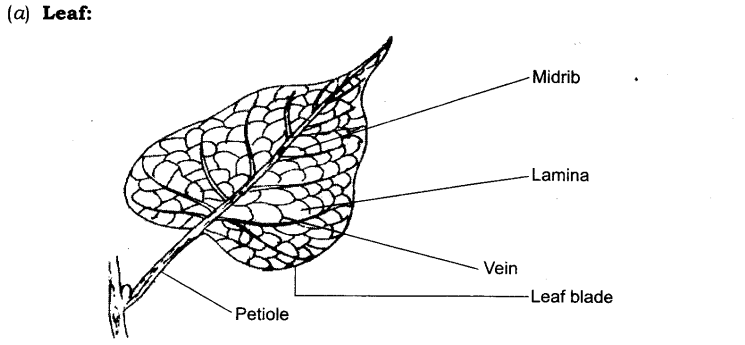
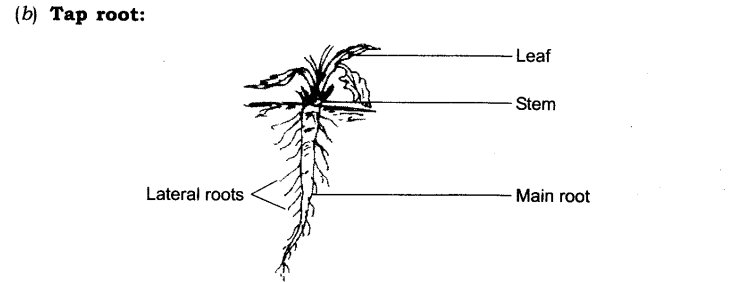
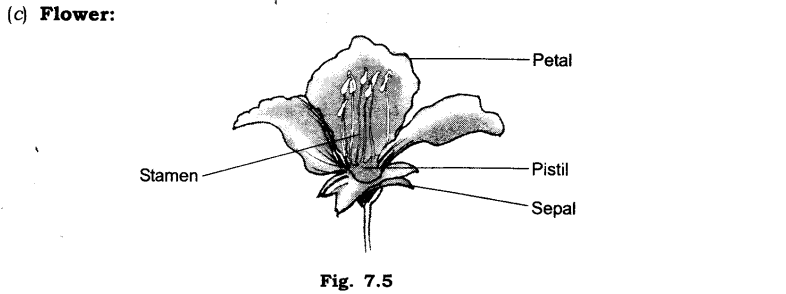
3. Can you find a plant in your house or in your neighbourhood which has a long but a weak stem? Write its name. In which category would you classify it?
Ans: Yes, we find a money plant in our house. It is a climber.
4. What is the function of a stem in a plant?
Ans: A stem performs following functions:
(i) The stem and its branches hold leaves to get maximum sunlight.
(ii) It transports water from roots to different parts of the plant.
(iii) It transports food from leaves to different parts of the plant.
(iv) It bears leaves, flowers and fruits.
5. Which of the following leaves have reticulate venation?
Wheat, tulsi, maize, grass, coriander (dhania), china rose.
Ans: Tulsi, china rose.
6. If a plant has fibrous root, what type of venation are its leaves likely to have?
Ans: Parallel venation.
7. If a plant has leaves with reticulate venation, what kind of roots will it have?
Ans:Tap root.
8. Is it possible for you to recognise the leaves without seeing them? How?
Ans: We cannot exactly recognise the leaves without seeing them. We may be able to have some idea by touching and smelling them.
9. Write the names of the parts of a flower in sequence, from outside to inside.
Ans: The names of various parts of a flower from outside to inside are:
(i) Sepals
(ii) Petals
(iii) Stamens
(iv) Pistil
10. Which of the following plants have you seen? Of those that you have seen, which one have flowers?
Grass, maize, wheat, chilli, tomato, tulsi, pipal, shisham, banyan, mango, jamun, guava, pomegranate, papaya, banana, lemon, sugarcane, potato, groundnut
Ans:
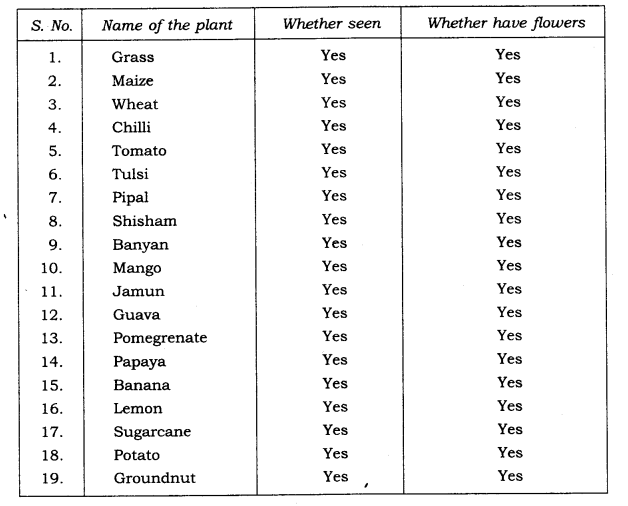
11. Name the part of the plant which produces its food. Name this process.
Ans: Leaves produce food for the plant. This process is called photosynthesis.
12. In which part of a flower you are likely to find the ovary?
Ans: We find ovary in pistil. It is the lowermost part of the pistil.
13. Name two flowers, each with joined and separates sepals.
Ans:
Flowers with joined sepals:
(i) Datura
(ii) Loki
Flowers with separate sepals:
(i) Gurhal
(ii) Mustard
EXTRA QUESTIONS for Class 6 Science Chapter 7
Class 6 Science Chapter 7 VERY SHORT ANSWER TYPE QUESTIONS
1. List few plants found around your house.
Ans: Mango, neem, grass, chilli, palak and banyan tree.
2. Are all the plants same in size?
Ans: No, all plants are of different sizes.
3. What are the major parts of plants?
Ans: Stem, root, leaves and flowers.
4. How many kinds of plants are there?
Ans: There are three kinds of plants:
(i) Herbs
(ii) Shrubs
(iii) Trees
5. Name two plants that belong to herbs.
Ans:
(i) Tomato
(ii) Potato
6. Give two examples of shrubs.
Ans:
(i) Lemon
(ii) Orange
7. Give two examples of trees.
Ans:
(i) Mango
(ii) Neem
8. Define petiole.
Ans: The part (stalk) of a leaf by which it is attached to the stem is called petiole.
9. What is lamina?
Ans: The broad green flat part of leaf is called lamina.
10. What are veins?
Ans: The lines on the leaf are called veins.
11. What is midrib?
Ans: A thick vein in the middle of the leaf is called midrib.
12. What is leaf venation?
Ans: The design made by veins in a leaf is called leaf venation.
13. How many types of leaf venation are there?
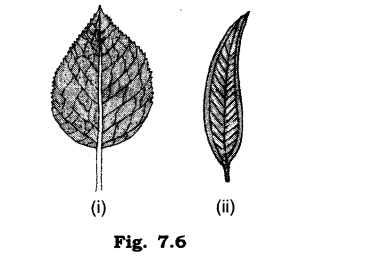
Ans: There are two types of leaf venation:
(i) Reticulate venation
(ii) Parallel venation
14. What is transpiration?
Ans: The process by which water comes out from the leaves in the form of vapour is called transpiration.
15. Name the process by which leaves can prepare their food.
Ans: This process is called photosynthesis.
16. What are the raw materials for photosynthesis?
Ans:
(i) Sunlight
(ii) Water
(iii) Carbon dioxide
(iv) Chlorophyll
17. Where does the photosynthesis take place in plants?
Ans: It takes place in the leaves.
18. Name the part of plant which helps in holding the plant in the soil.
Ans: Roots.
19. Name the types of roots shown in the Fig. 7.7.
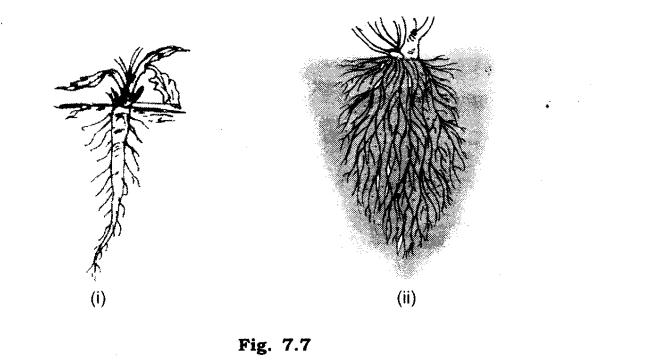
Ans: (i) Tap roots (ii) Fibrous roots
20. What are tap roots?
Ans: The roots in which one root is main root and other lateral roots grow on it are called tap roots.
21. Give names of two plants which have tap root.
Ans: Gram and mustard.
Q. 22. Name two plants which have fibrous root.
Ans: (i) Wheat plant (ii) Maize plant
23. What are lateral roots?
Ans: The smaller roots that grow on the main tap root are called lateral roots.
24. What are fibrous roots?
Ans: The roots which do not have any main root but all the roots are similar are called fibrous root.
25. Does the stem prepare food for any plant?
Ans: Yes, there are some plants whose stem prepares food, e.g. cactus.
26. Name the prominent parts of a flower.
Ans: The prominent parts of a flower are petals, sepals, stamens and pistil.
27. What are sepals? What are their functions?
Ans: The small green coloured leaf-life structures are called sepals. It protects flower when it is in stage of bud.
28. What are petals? Why are they generally coloured?
Ans: The coloured big leaf-life structures present in flower are called petals. Petals are coloured so as to attract insects for pollination.
29. What are stamens?
Ans:When we remove sepals and petals from the flower then we see some filaments in the flower which are called stamens. These, are the male part of the flower.
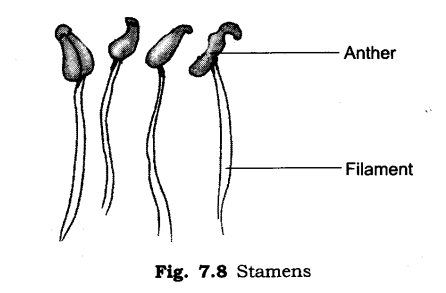
30. Name various parts of stamen.
Ans: There are two parts of a stamen:
(i) Anther (ii) Filament.
These are the male part of the flowers.
31. What is pistil?
Ans: The innermost part of a flower is called pistil. These are the female part of the flowers.
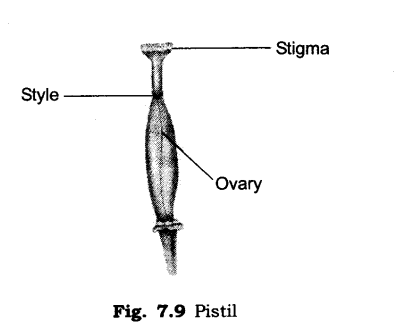
32. Name the various parts of pistil.
Ans: There are three parts of pistil:
(i) Stigma (ii) Style (iii) Ovary
33. What are ovules?
Ans: These are small bead-like structures inside the ovaiy.
Class 6 Science Chapter 7 SHORT ANSWER TYPE QUESTIONS
1. What are weeds?
Ans: The unwanted plants that grow in the fields with the main crops or in their surroundings are called weeds. Weeds are the plants which are not grown by the farmers. For example, grass.
2. Classify plants and give an example of each.
Ans: On the basis of various characteristics most of the plants can be classified into three categories:
(i) Herbs, e.g. tomato
(ii) Shrubs, e.g. lemon
(iii) Trees, e.g. mango
3. What are herbs? Give two examples.
Ans: The plants with green and tender stems are called herbs. They are usually short and may have no or less branches. For example, tomato, potato.
4. What are shrubs? Give two examples.
Ans: The plants which have a hard but not a very thick stem are called shrubs. Such plants have the stem branching out near the base. For example, lemon, rose plants.
5. What are trees? Give two examples.
Ans: The plants which are very tall and have hard and thick brown stem are called trees. The stems have branches in upper part and much above the ground. For example, mango, neem.
6. What are creepers? Write an example.
Ans. The plants with weak stem that cannot stand upright and spread on the ground are called creepers. Various types of grasses are the examples of creepers.
7. What are climbers?
Ans: The plants that take support of neighbouring structures and climb up are called climbers. They have weak stem. For example, grapes, money plant, beans.
8. Explain an activity to show that stem conducts water and other substances.
Ans: Take some water in a glass. Add few drops of red ink to the water. Cut the stem of a herb plant from its base. Put it in the glass as shown in figure. We will see that some parts of the stem become red. This activity shows that stem conducts water.
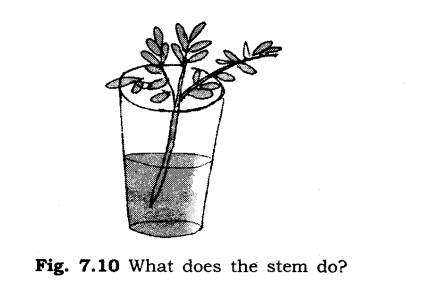
9. Explain the structure of a leaf with the help of a labelled diagram.
Ans: There are two main parts of leaf:
(i) Petiole: The part of the leaf by which it is attached to the stem is called petiole.
(ii) Lamina: The broad, green part of the leaf is called lamina.

The lamina contains following parts:
(i) Veins: There are various types of lines on the leaf. These lines are called veins
(ii) Midrib: There is a thick vein in the middle of the leaf. This vein is called midrib.
10. Explain the main functions of leaf.
Ans: There are following two main functions of leaf:
(i) Transpiration: The extra water comes out of the leaves in the form of vapour. This process is called transpiration.
(ii) Photosynthesis: The process by which leaves prepare their food from water and carbon dioxide, in the presence of sunlight and a green-coloured substance, is called photosynthesis.
11. What are unisexual and bisexual flowers?
Ans: Unisexual flower has either male (stamen) or female (pistil) parts.
Bisexual flowers have both male and female whorl in the flowers, i.e., they have both stamen and pistil.
12. Name a plant that eats insect.
Ans: Pitcher plant.
13. Pitcher plant has green leaves which can prepare food by photosynthesis then why does it eat insects?
Ans: To get nitrogenous compounds which it cannot absorb from the soil.
14. Name a plant that has underground as well as aerial (above the ground) root system.
Ans: Banyan tree.
15. Why do we see dew drops on leaves in the early morning?
Ans: At night the water lost by leaves does not get evaporated and gets collected on the leaves in the form of dew drops.
16. Why are petals colourful?
Ans: The colourful petals attract insects for pollination.
17. Why does white flowers bloom at night?
Ans: White colour attracts night insects for pollination.
18. What do you mean by a complete and incomplete flower?
Ans: The flower with all whorls, i.e., sepals, petals, stamen and carpel in it is a complete flower. If any one of this is absent in a flower it is called an incomplete flower.
19. Leaves need oxygen and carbon-dioxide (for photosynthesis). How do they get these gases?
Ans: Leaves take in these gases from atmosphere through small pores present on them called stomata.
20. How can one destarch the leaves of potted plant without plucking, them?
Ans: By keeping it in dark for 2-3 days.
21. What is the relation between leaf venation and the type of roots?
Ans: The plants having tap root have reticulate venation. The plants having fibrous roots have parallel venation.
22. Name the male part of a flower. Write names of its parts and draw a diagram.
Ans: The male part of a flower is called stamen. It has two parts: (i) Filament and (ii) Anther.
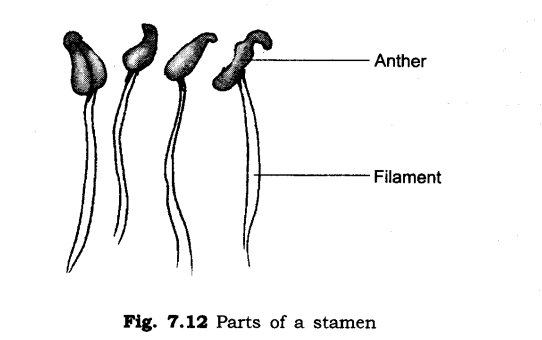
23.Name the female part of a flower. Write names of its parts and draw a diagram.
Ans:The female part of a flower is called pistil. It has three parts: (i) Stigma, (ii) Style, and (iii) Ovary.
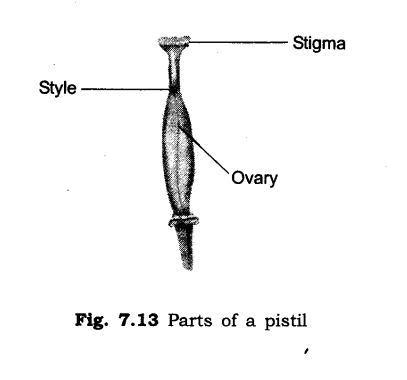
24. Differentiate between tap root and fibrous root.
Ans:
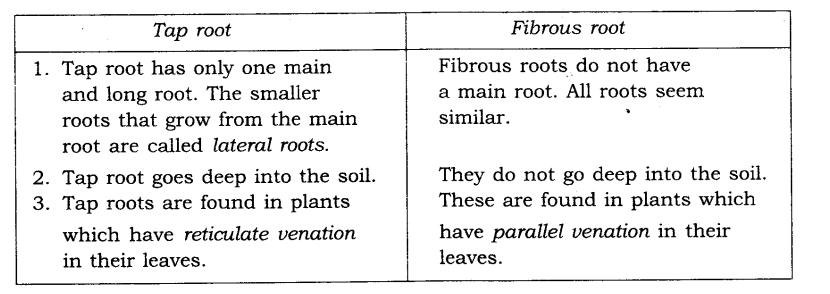
Class 6 Science Chapter 7 LONG ANSWER TYPE QUESTIONS
1. What do you mean by leaf venation? Explain various types of leaf venation with example.
Ans: Leaf venation: The design made by veins in a leaf is called leaf venation. There are the following two types of leaf venation:
(i) Reticulate venation: If the design of veins makes a net-like structure on both the sides of midrib then it is called reticulate venation. For example, mango leaf, gram leaf.
(ii) Parallel venation: If the veins are parallel to each other or to midrib then such type of venation is called parallel venation. For example, wheat leaf, barley leaf.
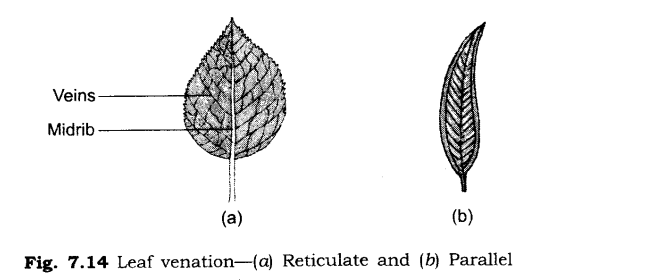
2. Explain the structure of a typical flower with the help of a diagram.
Ans: A typical flower contains the following parts:
(i) Stalk: The part by which a flower is attached to the branch is called stalk.
(ii) Sepals: The small green leaf-like structures of the flower are called sepals,
(iii) Petals: The big coloured leaf-like structures are called petals. Different flowers have petals of different colours.
(iv) Stamen: It is the male part of the flower. It has two parts: (a) Filament and (b) Anther.
(v) Pistil: The innermost part of a flower is called pistil. It has three parts: (a) Stigma, (b) Style and (c) Ovary. It is the female part of the flower.
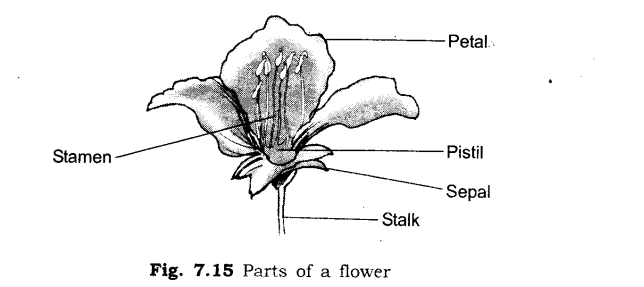
3. Explain an activity to test the presence of starch in a leaf.
Ans: Take a leaf in a test tube and pour spirit till it completely covers the leaf. Now put the test tube in a beaker having water. Heat the beaker till all the green colour from the leaf comes out into the spirit in the test tube. Take out the leaf and wash it with water. Put it on a plate and pour some iodine solution over it. The iodine solution is brown in colour but when it comes in contact with starch it turns blue-black. The iodine solution will turn blue-black when dropped on the leaf, this confirms the presence of starch in the leaf.
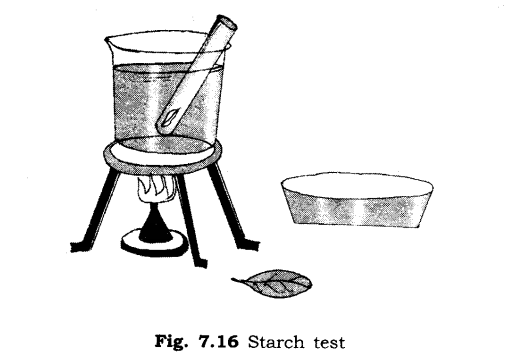
4. Explain that sunlight is essential for photosynthesis.
Ans: Take a potted plant having green leaves. Place it in a dark room for a day or two so that all the starch present in leaves is used by the plant. Now cover a portion of leaf with black paper and keep the plant in the sun for a day. Pluck the leaf, remove the black paper and test it for the starch. We see that only that part of the leaf becomes blue-black which was open to sun. The covered part does not become blue-black. This shows that no starch is formed because it gets no sunlight.
5. Explain the important functions of root.
Ans:. The following are the functions of root:
(i) They help to absorb water from the soil.
(ii) The roots help in holding the plants firmly in the soil.
(iii) They are said to anchor the plant to the soil.
6. Explain various kinds of roots with the help of an example.
Ans: There are following two types of roots:
(i) Tap roots: The roots which have one main root and other smaller lateral roots are called tap roots. For example, mustard plant, gram.
(ii) Fibrous roots: The roots which have no main root but all the roots appear similar are called fibrous roots. For example, maize, wheat.
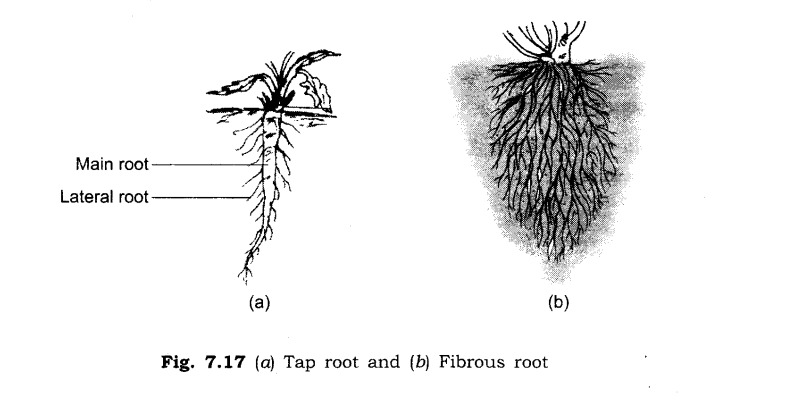
NCERT Solutions for Class 6 Science – All Chapters
- Chapter 1 The Wonderful World of Science
- Chapter 2 Diversity in the Living World
- Chapter 3 Mindful Eating: A Path to a Healthy Body
- Chapter 4 Exploring Magnets
- Chapter 5 Measurement of Length and Motion
- Chapter 6 Materials Around Us
- Chapter 7 Temperature and its Measurement
- Chapter 8 A Journey through States of Water
- Chapter 9 Methods of Separation in Everyday Life
- Chapter 10 Living Creatures: Exploring their Characteristics
- Chapter 11 Nature’s Treasures
- Chapter 12 Beyond Earth